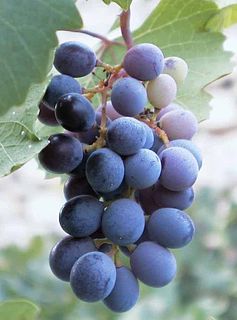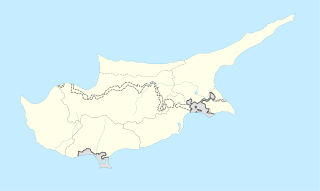Kapilio Καπηλιό | |
|---|---|
 View of Kapilio from the north | |
| Coordinates: 34°49′57″N32°57′30″E / 34.83250°N 32.95833°E Coordinates: 34°49′57″N32°57′30″E / 34.83250°N 32.95833°E | |
| Country | |
| District | Limassol |
| Elevation | 550 m (1,800 ft) |
| Population (2001) | |
| • Total | 30 |
| [1] | |
Kapilio (Greek : Καπηλιό) is a small village in the Limassol region of Cyprus. It is located in the area famous for its Commandaria wine, built on a slight elevation in the valley of the Ambelikos river to the east of the Troodos mountain range.

Greek is an independent branch of the Indo-European family of languages, native to Greece, Cyprus and other parts of the Eastern Mediterranean and the Black Sea. It has the longest documented history of any living Indo-European language, spanning more than 3000 years of written records. Its writing system has been the Greek alphabet for the major part of its history; other systems, such as Linear B and the Cypriot syllabary, were used previously. The alphabet arose from the Phoenician script and was in turn the basis of the Latin, Cyrillic, Armenian, Coptic, Gothic, and many other writing systems.

A village is a clustered human settlement or community, larger than a hamlet but smaller than a town, with a population ranging from a few hundred to a few thousand. Though villages are often located in rural areas, the term urban village is also applied to certain urban neighborhoods. Villages are normally permanent, with fixed dwellings; however, transient villages can occur. Further, the dwellings of a village are fairly close to one another, not scattered broadly over the landscape, as a dispersed settlement.

Limassol is a city on the southern coast of Cyprus and capital of the eponymous district. Limassol is the second largest urban area in Cyprus after Nicosia, with an urban population of 183,658 and a metropolitan population of 239,842. Limassol has been ranked by TripAdvisor as the 3rd up-and-coming destination in the world, in its Top 10 Traveler’s Choice Destinations on the Rise. The city is also ranked 89th worldwide in Mercer's Quality of Living Survey (2017). In the ranking published by the Globalization and World Cities Research Network, Limassol has been classified global city in the 4th category.
The main village church is dedicated to Saint George the Triumphant (Greek : Άγιος Γεώργιος ο Τροπαιοφόρος) and dates to the 12th century. There are two other smaller churches in the settlement, both dedicated to The Virgin, (The Virgin of the Vineyards and the Virgin of the Baths). [2]

Saint George was a soldier of Cappadocian Greek origins, member of the Praetorian Guard for Roman emperor Diocletian who was sentenced to death for refusing to recant his Christian faith. He became one of the most venerated saints and megalo-martyrs in Christianity, and was especially venerated as a military saint since the Crusaders.
Local inhabitants are mainly involved in viticulture as well as a growing almonds and other fruit trees and the village was famous in the past for its peaches.

Viticulture or winegrowing is the cultivation and harvesting of grapes. It is a branch of the science of horticulture. While the native territory of Vitis vinifera, the common grape vine, ranges from Western Europe to the Persian shores of the Caspian Sea, the vine has demonstrated high levels of adaptability to new environments. For this reason, viticulture can be found on every continent except Antarctica.

The almond is a species of tree native to Mediterranean climate regions of the Middle East, but widely cultivated elsewhere. The almond is also the name of the edible and widely cultivated seed of this tree. Within the genus Prunus, it is classified with the peach in the subgenus Amygdalus, distinguished from the other subgenera by corrugations on the shell (endocarp) surrounding the seed.

A fruit tree is a tree which bears fruit that is consumed or used by humans and some animals — all trees that are flowering plants produce fruit, which are the ripened ovaries of flowers containing one or more seeds. In horticultural usage, the term 'fruit tree' is limited to those that provide fruit for human food. Types of fruits are described and defined elsewhere, but would include "fruit" in a culinary sense, as well as some nut-bearing trees, such as walnuts.

















